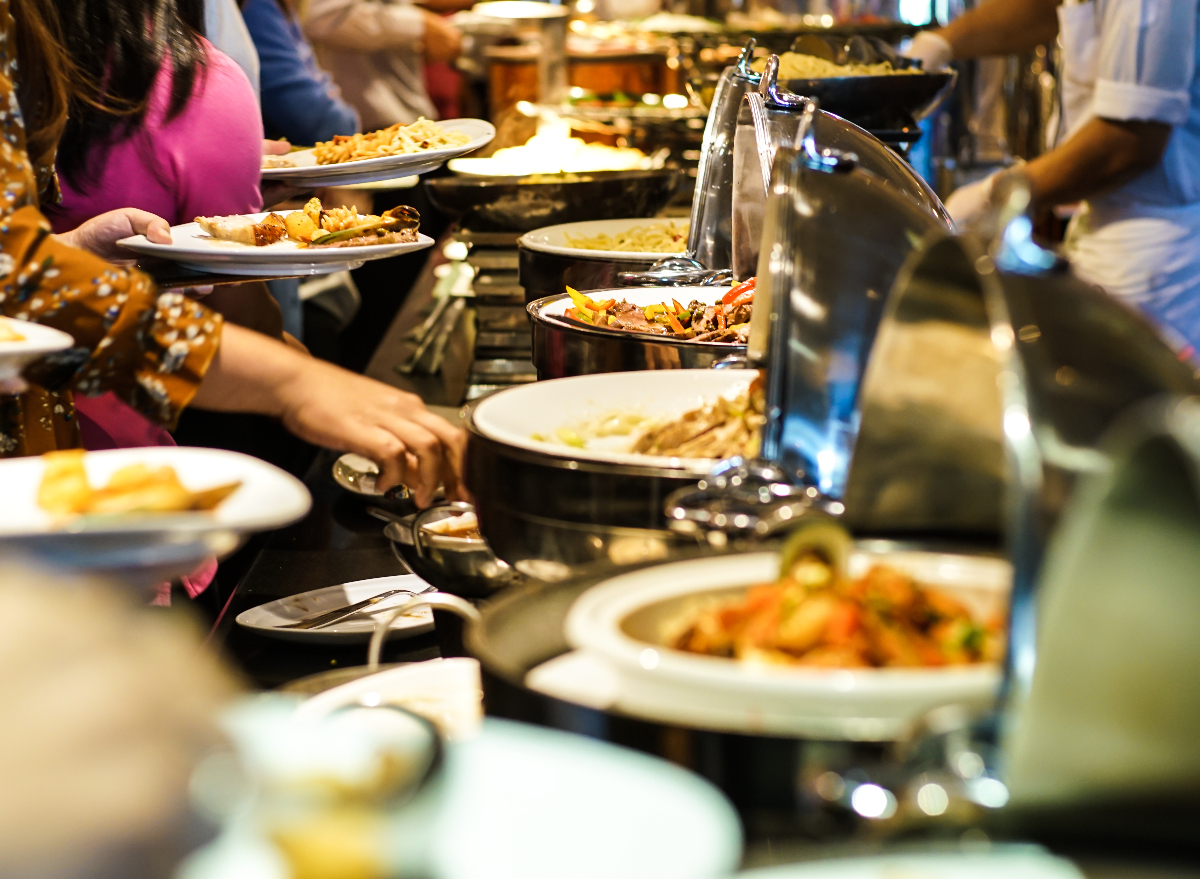The #1 Thing To Never Get at a Buffet, According to Experts

Restaurant concepts can’t survive off nostalgia alone—just ask a few legendary steakhouses lost to time. Despite an engrained sense of comfort and Americana, the popularity of certain dining styles have waned over the years, which might explain why buffets have gone the way of Blockbuster.
In terms of public perception, they’ve really taken a hit in recent years, deemed by many to not only to be unhealthy on a nutritional level, but also a huge risk during the pandemic. And really, all-you-can-eat waffles aren’t really something worth risking your health for.
The outlook for buffets has become so bleak that Golden Corral, America’s preeminent buffet king, has undergone mass closures. Meanwhile, several other buffet chains are on the brink of bankruptcy, and even Popeyes has shuttered its last buffet location.
Unlike typical full-service restaurants, or even fast-food restaurants for that matter, the key difference with buffets is that food is pre-cooked, left out, and (hopefully) maintained at proper temperatures for customers to serve themselves. It’s a longstanding staple in Americana dining, but evolving public preferences have not been kind to the once-mighty buffet.
Nowadays, the buffets that remain have become somewhat of a nostalgic novelty in their own right. And if you do visit a buffet, there are certainly red flags to look for, and certain things to avoid. Namely: items that are likely to get you sick, whether due to improper maintenance or an overloaded plate brimming with carbs.
“With salad bars, the one thing I avoid is a salad bar that is not well maintained,” says Martin Bucknavage, senior food safety extension associate at Penn State Department of Food Science. “That is, cold items are not cold, or hot items are not hot.”
Rather than point to a particular dish or style of cooking, the food safety expert emphasizes the importance of sanitation and proper cooking and temperature in general. For instance, if the food does not look fresh and appears like it has been out for hours—à la saggy lettuce or the separation of liquid in potato or tuna salad—then don’t eat it.
Bucknavage also says it’s important to only eat at buffets that are policed by service staff, ensuring the bar remains tidy, the utensils are in the right place, and people aren’t getting up under the sneeze guard.
Beyond sanitation, the other key factor to consider with buffets is nutrition. As notorious as they can be from a public health standpoint, buffets can also be a breeding ground of bad decisions. According to registered dietitian Amy Goodson, buffets are a challenging place to eat because when more food is available, people tend to overeat.
To counter that, she suggests managing your intake ahead of time by using smaller plates. “Typically, buffets have salad and entree plates, and a good goal is to use the smaller plate when you go through the line.” Additionally, watch how many times you go through the line and give your body a chance to digest the first helping before you head out there for helping #2. “It takes time for your body to recognize fullness, so after you finish plate one, be sure to sit there for 15-20 minutes before you fill your plate again.” Finally, try using Goodson’s plate rule, which means creating a balanced meal that’s 1/3 lean protein, 1/3 whole-grain carbohydrate, and 1/3 vegetables.
Something Goodson suggests avoiding is breaded proteins. “Whether they are pan-fried or deep-fried, it’s bread soaking up oil, which leads to more calories. Look for baked, grilled, and pan-seared proteins to put on your plate.”
Another thing to avoid? The sauces. Many pasta and casserole dishes have a bunch of creamy sauce in or on them, which usually means more saturated fat and calories. “Look for entrees and side items that are lightly sautéed, have a marinara sauce base, or are sauce-free to decrease the fat content of your buffet meal,” suggests Goodson.
And unless you’re indeed running a marathon imminently, be careful not to overload on carbs. “Most of the time, buffets are loaded with pastas, risottos, casseroles, breads, and other delicious carbs,” she says. “Let’s be clear, carbohydrates are good for you and you need some of them on your plate, but it is often easy to go overboard. So, choose your favorite and eat that first, or get a smaller amount of a few options.”
Instead of eating several different types of carbs, add color to your plate in the form of fruits and vegetables, which are not only loaded with nutrients, but have more fiber and less calories which will help you feel full faster. Just make sure none of those fruits and vegetables look like they’re sagging under the wrong temperature.









